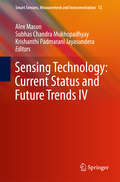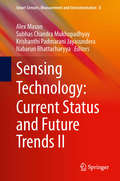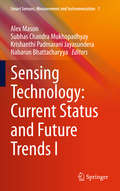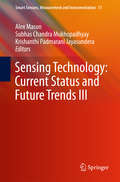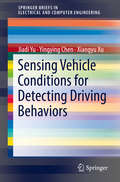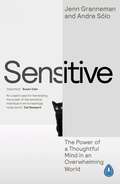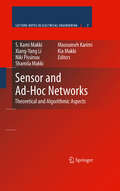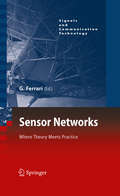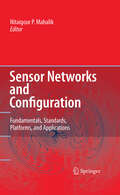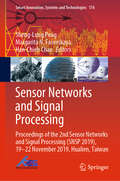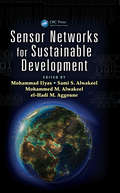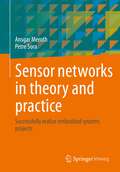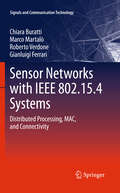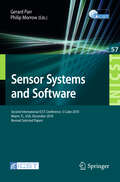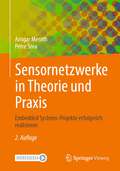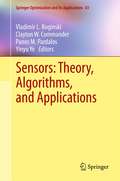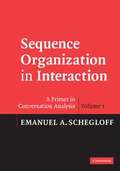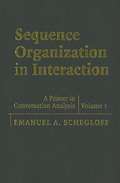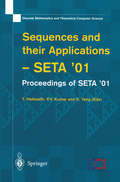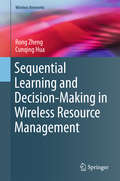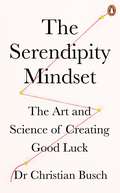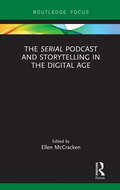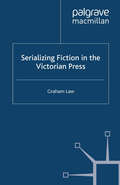- Table View
- List View
Sensing Technology: Current Status And Future Trends Iv (Smart Sensors, Measurement and Instrumentation #12)
by Alex Mason Subhas Chandra Mukhopadhyay Krishanthi Padmarani JayasunderaThis book is written for academic and industry professionals working in the field of sensing, instrumentation and related fields, and is positioned to give a snapshot of the current state of the art in sensing technology, particularly from the applied perspective. The book is intended to give broad overview of the latest developments, in addition to discussing the process through which researchers go through in order to develop sensors, or related systems, which will become more widespread in the future.
Sensing Technology: Current Status And Future Trends Ii (Smart Sensors, Measurement and Instrumentation #8)
by Alex Mason Subhas Chandra Mukhopadhyay Krishanthi Padmarani Jayasundera Nabarun BhattacharyyaThis book is written for academic and industry professionals working in the field of sensing, instrumentation and related fields, and is positioned to give a snapshot of the current state of the art in sensing technology, particularly from the applied perspective. The book is intended to give broad overview of the latest developments, in addition to discussing the process through which researchers go through in order to develop sensors, or related systems, which will become more widespread in the future.
Sensing Technology: Current Status And Future Trends I (Smart Sensors, Measurement and Instrumentation #7)
by Alex Mason Subhas Chandra Mukhopadhyay Krishanthi Padmarani Jayasundera Nabarun BhattacharyyaThis book is written for academic and industry professionals working in the field of sensing, instrumentation and related fields, and is positioned to give a snapshot of the current state of the art in sensing technology, particularly from the applied perspective. The book is intended to give a broad overview of the latest developments, in addition to discussing the process through which researchers go through in order to develop sensors, or related systems, which will become more widespread in the future.
Sensing Technology: Current Status and Future Trends III (Smart Sensors, Measurement and Instrumentation #11)
by Alex Mason Subhas Chandra Mukhopadhyay Krishanthi Padmarani JayasunderaThis book contains a collection of selected works stemming from the 2013 International Conference on Sensing Technology (ICST), which was held in Wellington, New Zealand. The purpose of the book is to distill the highlights of the conference, and therefore track the latest developments in sensing technologies. The book contents are broad, since sensors can be applied in many different areas. Therefore the book gives a broad overview of the latest developments, in addition to discussing the process through which researchers go through in order to develop sensors, or related systems, which will become more widespread in the future. The book is written for academic and industry professionals working in the field of sensing, instrumentation and related fields, and is positioned to give a snapshot of the current state of the art in sensing technology, particularly from the applied perspective.
Sensing Vehicle Conditions for Detecting Driving Behaviors (SpringerBriefs in Electrical and Computer Engineering)
by Jiadi Yu Yingying Chen Xiangyu XuThis SpringerBrief begins by introducing the concept of smartphone sensing and summarizing the main tasks of applying smartphone sensing in vehicles. Chapter 2 describes the vehicle dynamics sensing model that exploits the raw data of motion sensors (i.e., accelerometer and gyroscope) to give the dynamic of vehicles, including stopping, turning, changing lanes, driving on uneven road, etc. Chapter 3 detects the abnormal driving behaviors based on sensing vehicle dynamics. Specifically, this brief proposes a machine learning-based fine-grained abnormal driving behavior detection and identification system, D3, to perform real-time high-accurate abnormal driving behaviors monitoring using the built-in motion sensors in smartphones.As more vehicles taking part in the transportation system in recent years, driving or taking vehicles have become an inseparable part of our daily life. However, increasing vehicles on the roads bring more traffic issues including crashes and congestions, which make it necessary to sense vehicle dynamics and detect driving behaviors for drivers. For example, sensing lane information of vehicles in real time can be assisted with the navigators to avoid unnecessary detours, and acquiring instant vehicle speed is desirable to many important vehicular applications. Moreover, if the driving behaviors of drivers, like inattentive and drunk driver, can be detected and warned in time, a large part of traffic accidents can be prevented. However, for sensing vehicle dynamics and detecting driving behaviors, traditional approaches are grounded on the built-in infrastructure in vehicles such as infrared sensors and radars, or additional hardware like EEG devices and alcohol sensors, which involves high cost. The authors illustrate that smartphone sensing technology, which involves sensors embedded in smartphones (including the accelerometer, gyroscope, speaker, microphone, etc.), can be applied in sensing vehicle dynamics and driving behaviors. Chapter 4 exploits the feasibility to recognize abnormal driving events of drivers at early stage. Specifically, the authors develop an Early Recognition system, ER, which recognize inattentive driving events at an early stage and alert drivers timely leveraging built-in audio devices on smartphones. An overview of the state-of-the-art research is presented in chapter 5. Finally, the conclusions and future directions are provided in Chapter 6.
Sensitive: The Power of a Thoughtful Mind in an Overwhelming World
by Jenn Granneman Andre Sólo'A natural follow up to Susan Cain's Quiet' - The Sunday Times Style'The authors paint an illuminating portrait of highly sensitive people' - Financial Times*****Have you ever been told you're too sensitive? Welcome to the club.Nearly 1 in 3 people have the genes to be more sensitive than others. But what if we said it doesn't have to be the insult it's always been framed as?Highly sensitive people:· Have a heightened sense of empathy· Tune into subtle details and make connections that others miss· Are often wonderfully creativeThrough fascinating research, expert storytelling and practical insight, this book will teach you how to unlock the potential in this undervalued strength and leverage it in your relationships, your work and your life.Shattering the myth that being sensitive is a weakness, Sensitive will change - once and for all - how the world sees sensitive people, and how they see themselves.
Sensor and Ad-Hoc Networks: Theoretical and Algorithmic Aspects (Lecture Notes in Electrical Engineering #7)
by Xiang-Yang Li Kia Makki S. Kami Makki Niki Pissinou Masoumeh Karimi Shamila MakkiThis book brings together leading researchers and developers in the field of wireless sensor networks to explain the special problems and challenges of the algorithmic aspects of sensor and ad-hoc networks. The book also fosters communication not only between the different sensor and ad-hoc communities, but also between those communities and the distributed systems and information systems communities. The topics addressed pertain to the sensors and mobile environment.
Sensor Networks: Where Theory Meets Practice (Signals and Communication Technology)
by Gianluigi FerrariThe idea of this book comes from the observation that sensor networks represent a topic of interest from both theoretical and practical perspectives. The title und- lines that sensor networks offer the unique opportunity of clearly linking theory with practice. In fact, owing to their typical low-cost, academic researchers have the opportunity of implementing sensor network testbeds to check the validity of their theories, algorithms, protocols, etc., in reality. Likewise, a practitioner has the opportunity of understanding what are the principles behind the sensor networks under use and, thus, how to properly tune some accessible network parameters to improve the performance. On the basis of the observations above, the book has been structured in three parts:PartIisdenotedas“Theory,”sincethetopicsofits vechaptersareapparently “detached” from real scenarios; Part II is denoted as “Theory and Practice,” since the topics of its three chapters, altough theoretical, have a clear connection with speci c practical scenarios; Part III is denoted as “Practice,” since the topics of its ve chapters are clearly related to practical applications.
Sensor Networks and Configuration: Fundamentals, Standards, Platforms, and Applications
by Nitaigour P. MahalikThis book incorporates a selection of research and development papers. Its scope is on history and background, underlying design methodology, application domains and recent developments. The readers will be able to understand the underlying technology, philosophy, concepts, ideas, and principles, with regard to broader areas of sensor network. Aspects of sensor network and experimental results have been presented in proper order.
Sensor Networks and Signal Processing: Proceedings of the 2nd Sensor Networks and Signal Processing (SNSP 2019), 19-22 November 2019, Hualien, Taiwan (Smart Innovation, Systems and Technologies #176)
by Sheng-Lung Peng Margarita N. Favorskaya Han-Chieh ChaoThis book offers a collection of high-quality research papers presented at the 2nd International Conference on Sensor Networks and Signal Processing (SNSP 2019), held in Taiwan on November 19–22, 2019. It presents novel contributions in the areas of sensor and actuator networks, wireless networks, networking and protocols, security and privacy, wireless communications, distributed algorithms, Internet of Things, system modeling and performance analysis, fault tolerance/diagnostics, information management, data mining and analysis, embedded systems design, signal theory, signal and image processing, detection and estimation, spectral analysis, software developments, pattern recognition, data processing, remote sensing, big data, machine learning, information and coding theory, and industrial applications.
Sensor Networks for Sustainable Development
by Mohammad IlyasRecent advances in technology and manufacturing have made it possible to create small, powerful, energy-efficient, cost-effective sensor nodes for specialized telecommunication applications—nodes "smart" enough to be capable of adaptation, self-awareness, and self-organization. Sensor Networks for Sustainable Development examines sensor network technologies that increase the quality of human life and encourage societal progress with minimal effect on the earth’s natural resources and environment. Organized as a collection of articles authored by leading experts in the field, this valuable reference captures the current state of the art and explores applications where sensor networks are used for sustainable development in: Agriculture Environment Energy Healthcare Transportation Disaster management Beneficial to designers and planners of emerging telecommunication networks, researchers in related industries, and students and academia seeking to learn about the impact of sensor networks on sustainable development, Sensor Networks for Sustainable Development provides scientific tutorials and technical information about smart sensor networks and their use in everything from remote patient monitoring to improving safety on the roadways and beyond.
Sensor Networks for Sustainable Development
by Mohammad Ilyas Sami S. Alwakeel Mohammed M. Alwakeel el-Hadi M. AggouneRecent advances in technology and manufacturing have made it possible to create small, powerful, energy-efficient, cost-effective sensor nodes for specialized telecommunication applications—nodes "smart" enough to be capable of adaptation, self-awareness, and self-organization. Sensor Networks for Sustainable Development examines sensor network technologies that increase the quality of human life and encourage societal progress with minimal effect on the earth’s natural resources and environment. Organized as a collection of articles authored by leading experts in the field, this valuable reference captures the current state of the art and explores applications where sensor networks are used for sustainable development in: Agriculture Environment Energy Healthcare Transportation Disaster management Beneficial to designers and planners of emerging telecommunication networks, researchers in related industries, and students and academia seeking to learn about the impact of sensor networks on sustainable development, Sensor Networks for Sustainable Development provides scientific tutorials and technical information about smart sensor networks and their use in everything from remote patient monitoring to improving safety on the roadways and beyond.
Sensor networks in theory and practice: Successfully realize embedded systems projects
by Ansgar Meroth Petre SoraThe book provides an important foundation for understanding the Internet of Things by offering insight into common networking protocols from the microcontroller world and introducing important sensors and other devices, as well as their use and programming. All concepts shown are illustrated with practical circuit and programming examples from the authors' many years of experience. In addition, open libraries for controlling the devices presented in the book are available for readers to download from the publisher's home page. The second edition includes some new devices, especially in the area of networks, a more detailed description of the operating principles of some sensors as well as further tips and tricks for programming.
Sensor Networks with IEEE 802.15.4 Systems: Distributed Processing, MAC, and Connectivity (Signals and Communication Technology)
by Chiara Buratti Marco Martalo' Roberto Verdone Gianluigi FerrariThis book presents a simple, yet complete, approach to the design and performance analysis of distributed processing algorithms and techniques suitable for IEEE 802.15.4 networks. In particular, the book focuses on the bottom two layers of the ISO/OSI stack (Physical and Medium Access Control), discussing also a few issue related to routing. The book is a the synergistic combination of signal processing aspects on the one hand and MAC and connectivity issues on the other hand. The goal of the book is to clearly link physical layer aspects with medium access and topology aspects, in order to provide the reader with a clear understanding of how to approach the design of proper distributed signal processing and medium access algorithms in this context.
Sensor Systems and Software: Second International ICST Conference, S-Cube 2010, Miami, FL, December 13-15, 2010, Revised Selected Papers (Lecture Notes of the Institute for Computer Sciences, Social Informatics and Telecommunications Engineering #57)
by Gerard Parr Philip MorrowThis book constitutes the thoroughly refereed post-conference proceedings of the Second International ICST Conference on Sensor Systems and Software, S-Cube 2010, held in Miami, Florida, USA, in December 2010. The 17 revised full papers presented were carefully reviewed and selected and cover a wide range of topics including sensor application programming paradigms, novel sensor applications, sensor network middleware, trust security and privacy, wireless sensor network management and monitoring, and sensor application development support systems.
Sensornetzwerke in Theorie und Praxis: Embedded Systems-Projekte erfolgreich realisieren
by Ansgar Meroth Petre SoraDas Buch bildet eine wichtige Grundlage für das Verständnis des Internet of Things, indem es einen Einblick in gängige Vernetzungsprotokolle aus der Mikrocontrollerwelt bietet und wichtige Sensoren und andere Bausteine, sowie deren Einsatz und Programmierung vorstellt. Alle gezeigten Konzepte werden durch praktische Schaltungs- und Programmierbeispiele aus den langjährigen Erfahrungen der Autoren illustriert. Daneben stehen den Lesern offene Bibliotheken für die Ansteuerung der im Buch präsentierten Bauteile auf der Verlagshomepage zum Herunterladen bereit. Die zweite Auflage beinhaltet einige neue Bausteine, insbesondere im Bereich der Netzwerke, eine ausführlichere Beschreibung der Funktionsprinzipien einiger Sensoren sowie weitere Tipps und Tricks zum Programmieren.
Sensors: Theory, Algorithms, And Applications (Springer Optimization and Its Applications #61)
by Vladimir L. Boginski, Clayton W. Commander, Panos M. Pardalos and Yinyu YeThe objective of this book is to advance the current knowledge of sensor research particularly highlighting recent advances, current work, and future needs. The goal is to share current technologies and steer future efforts in directions that will benefit the majority of researchers and practitioners working in this broad field of study.
Sequence Organization In Interaction: A Primer In Conversation Analysis (PDF)
by Emanuel A. SchegloffMuch of our daily lives are spent talking to one another, in both ordinary conversation and more specialized settings such as meetings, interviews, classrooms, and courtrooms. It is largely through conversation that the major institutions of our society - economy, religion, politics, family and law - are implemented. This book Emanuel Schegloff, the first in a series and first published in 2007, introduces the findings and theories of conversation analysis. Together, the volumes in the series constitute a complete and authoritative 'primer' in the subject. The topic of this first volume is 'sequence organization' - the ways in which turns-at-talk are ordered and combined to make actions take place in conversation, such as requests, offers, complaints, and announcements. Containing many examples from real-life conversations, it will be invaluable to anyone interested in human interaction and the workings of conversation.
Sequence Organization In Interaction (PDF): A Primer In Conversation Analysis
by Emanuel A. SchegloffMuch of our daily lives are spent talking to one another, in both ordinary conversation and more specialized settings such as meetings, interviews, classrooms, and courtrooms. It is largely through conversation that the major institutions of our society - economy, religion, politics, family and law - are implemented. This book Emanuel Schegloff, the first in a series and first published in 2007, introduces the findings and theories of conversation analysis. Together, the volumes in the series constitute a complete and authoritative 'primer' in the subject. The topic of this first volume is 'sequence organization' - the ways in which turns-at-talk are ordered and combined to make actions take place in conversation, such as requests, offers, complaints, and announcements. Containing many examples from real-life conversations, it will be invaluable to anyone interested in human interaction and the workings of conversation.
Sequences and their Applications: Proceedings of SETA ’01 (Discrete Mathematics and Theoretical Computer Science)
by T. Helleseth P. V. Kumar K. YangPseudorandom sequences have widespread applications, for instance, in spread spectrum, code division multiple access, optical and ultrawide band communication systems, as well as in ranging systems global positioning systems, circuit testing and stream ciphers. Such sequences also have strong ties to error-correcting codes.This volume contains survey and research papers on sequences and their applications. It brings together leading experts from discrete mathematics, computer science and communications engineering, and helps to bridge advances in these different areas. Papers in this volume discuss the theory of sequences and their applications in cryptography, coding theory, communications systems, numerical computation and computer simulation.
Sequential Learning and Decision-Making in Wireless Resource Management (Wireless Networks)
by Rong Zheng Cunqing HuaThis book lays out the theoretical foundation of the so-called multi-armed bandit (MAB) problems and puts it in the context of resource management in wireless networks. Part I of the book presents the formulations, algorithms and performance of three forms of MAB problems, namely, stochastic, Markov and adversarial. Covering all three forms of MAB problems makes this book unique in the field. Part II of the book provides detailed discussions of representative applications of the sequential learning framework in cognitive radio networks, wireless LANs and wireless mesh networks. Both individuals in industry and those in the wireless research community will benefit from this comprehensive and timely treatment of these topics. Advanced-level students studying communications engineering and networks will also find the content valuable and accessible.
The Serendipity Mindset: The Art and Science of Creating Good Luck
by Dr Christian Busch'A wise, exciting and life-changing book' Arianna Huffington, author of Thrive'In this incisive book, Christian Busch reveals that luck isn't always dumb. People who can see what others don't - who are awake to the high probability of the improbable - can achieve and contribute in ways their more blinkered colleagues cannot. The Serendipity Mindset is a bracing and hopeful antidote to a world addicted to efficiency and control' Daniel H. Pink, bestselling author of When and Drive 'How to create the opportunities for a successful and fulfilling life? Christian Busch shows convincingly that it's more than blind luck in The Serendipity Mindset, which offers excellent practical guidance for all' Paul Polman, former CEO of Unilever and co-founder of IMAGINE ___________________________________________What if being lucky was a skill that you could master and share with other people?Modern life is full of chance encounters, changing plans, delayed journeys, human errors and other mishaps. So, what if we use such unpredictability to our advantage?Dr Christian Busch has spent a decade exploring how, if acted upon, unexpected encounters can enhance our worldview, expand our social circles and create new professional opportunities. In this book, Christian reveals the secrets behind the hidden force that rules the universe: serendipity.The Serendipity Mindset is a revolutionary, well-researched exploration of a well-researched and essential life skill that we can all develop in a few simple steps. By learning to identify, act on and share serendipity, we can use uncertainty as a pathway to more joyful, purposeful and successful lives. From couples who first interacted during chance encounters to businesspeople who invented multi-million ideas after a best-laid plan misfired, Christian has studied hundreds of subjects who improved their lives by learning to see opportunities in the unexpected.
The Serial Podcast and Storytelling in the Digital Age (Routledge Focus on Digital Media and Culture)
by Ellen McCrackenThis volume analyzes the Serial podcast, situating it in the trajectory of other popular crime narratives and contemporary cultural theory. Contributors focus on topics such as the ethics of the use of fiction techniques in investigative journalism, the epistemological overlay of postmodern indeterminacy, and the audience’s prolific activity in social media, examining the competing narrative strategies of the narrators, characters, and the audience. Other topics considered include the multiplication of narratives and the longing for closure, how our minds work as we experience true crime narratives, and what critical race theory can teach us about the program’s strategies.
The Serial Podcast and Storytelling in the Digital Age (Routledge Focus on Digital Media and Culture)
by Ellen McCrackenThis volume analyzes the Serial podcast, situating it in the trajectory of other popular crime narratives and contemporary cultural theory. Contributors focus on topics such as the ethics of the use of fiction techniques in investigative journalism, the epistemological overlay of postmodern indeterminacy, and the audience’s prolific activity in social media, examining the competing narrative strategies of the narrators, characters, and the audience. Other topics considered include the multiplication of narratives and the longing for closure, how our minds work as we experience true crime narratives, and what critical race theory can teach us about the program’s strategies.
Serializing Fiction in the Victorian Press
by G. LawDrawing on extensive archival research in both Britain and the United States, Serializing Fiction in the Victorian Press represents the first comprehensive study of the publication of instalment fiction in Victorian newspapers. Often overlooked, this phenomenon is shown to have exerted a crucial influence on the development of the fiction market in the last decades of the nineteenth century. A detailed description of the practice of syndication is followed by a wide-ranging discussion of its implications for readership, authorship, and fictional form.
